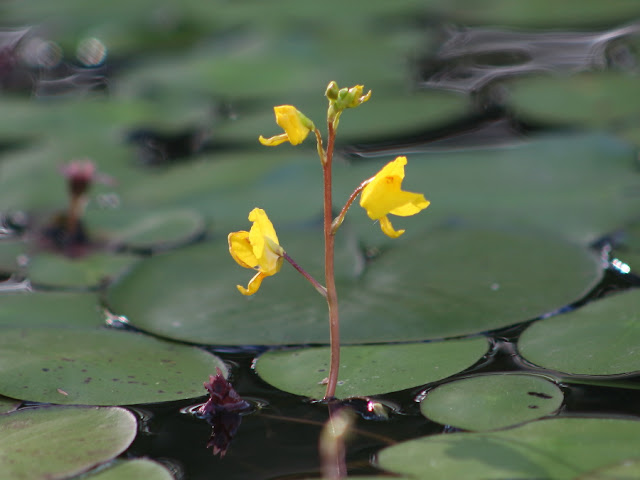Even people who have lived in Meredith all their lives don't know about this wetland, for two reasons: One, it's hidden behind the businesses along Routes 3 and 25, and two, its flow into Meredith Bay runs under the road and is largely invisible. But due to the tireless work of the Meredith Pathways Committee, a trail that includes a boardwalk along the wetlands and connects to a gravel path leading to Prescott Park is now complete and open to the everyone. And I do mean everyone, as the entire path is wheelchair accessible, accommodating those with limited mobility.
You can access it from either Prescott Park or the entrance behind the Meredith Village Savings Bank. It's worth investigating, and you have a good chance of seeing the Great Blue Heron that calls the brook home. I'll share a link to a trail map and description as soon as it's published.
When I walked the trail last week I noticed this pretty aquatic flower:
 |
Broadleaf arrowhead or Indian Potato (DescriptionSagittaria latifolia) |
This is a broadleaf arrowhead which has a large, edible tuber; it is also known as Indian potato. But if you see one, don't take it home for dinner! Leave it for others to enjoy! This plant is indigenous to North America, and was reportedly a staple of native Americans in this region.
Last Saturday the Loon Preservation Committee coordinated the annual loon census. It will be several weeks before the results are compiled, but Lake Wicwas recorded a total of twelve loons between 8:00 and 9:00 am: Seven on the water and five flying overhead. We are certain four of the loons are the nesting pair and their chicks, and are confident two more are the banded pair, and one is our rogue. Here are a few pictures from the census.
 |
| Our rogue loon. |
 |
| A pair of loons flies north over Lake Wicwas |
 |
| Flying and yodeling. |
A few days later on a morning paddle I came across Harold and Betty who were left alone far down the lake while both parents appeared to be keeping the other loons far away. At first the two chicks were huddled closely together.
 |
| Our little chicks are growing up. |
 |
| And stretching their tiny wings. |
But when they noticed me they quickly dove, surfacing some distance away. They then were very attentive to my presence. This gives me confidence they are now aware of their surroundings, and if they see an airborne predator on the approach they are certainly capable of diving long enough to protect themselves. These parents seem to be raising a couple of street-smart kids!
Finally, did you get a chance to see the comet?
 | |
| Comet Neowise streaks over Lake Wicwas. |
 |
| Comet Neowise won't return to Earth for 7000 years. |







































